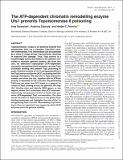The ATP-dependent chromatin remodelling enzyme Uls1 prevents Topoisomerase II poisoning
Abstract
Topoisomerase II (Top2) is an essential enzyme that decatenates DNA via a transient Top2-DNA covalent intermediate. This intermediate can be stabilised by a class of drugs termed Top2 poisons, resulting in massive DNA damage. Thus, Top2 activity is a double-edged sword that needs to be carefully controlled to maintain genome stability. We show that Uls1, an ATP-dependent chromatin remodelling (Snf2) enzyme, can alter Top2 chromatin binding and prevent Top2 poisoning in yeast. Deletion mutants of ULS1 are hypersensitive to the Top2 poison acriflavine (ACF), activating the DNA damage checkpoint. We map Uls1’s Top2 interaction domain and show that this, together with its ATPase activity, is essential for Uls1 function. By performing ChIP-seq, we show that ACF leads to a general increase in Top2 binding across the genome. We map Uls1 binding sites and identify tRNA genes as key regions where Uls1 associates after ACF treatment. Importantly, the presence of Uls1 at these sites prevents ACF-dependent Top2 accumulation. Our data reveal the effect of Top2 poisons on the global Top2 binding landscape and highlights the role of Uls1 in antagonising Top2 function. Remodelling Top2 binding is thus an important new means by which Snf2 enzymes promote genome stability.
Citation
Swanston , A , Zabrady , K & Ferreira , H C 2019 , ' The ATP-dependent chromatin remodelling enzyme Uls1 prevents Topoisomerase II poisoning ' , Nucleic Acids Research , vol. 47 , no. 12 , pp. 6172–6183 . https://doi.org/10.1093/nar/gkz362
Publication
Nucleic Acids Research
Status
Peer reviewed
ISSN
0305-1048Type
Journal article
Description
This work was supported by the Biotechnology and Biological Sciences Research Council [BB/M008142/1 to H.C.F.] and the University of St Andrews Bioinformatics Unit is supported by a Wellcome Trust ISSF Grant [105621/Z/14/Z]. Funding for open access charge: Biotechnology and Biological Sciences Research Council [BB/M008142/1].Collections
Items in the St Andrews Research Repository are protected by copyright, with all rights reserved, unless otherwise indicated.

